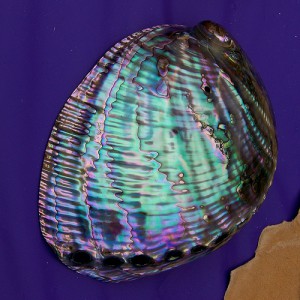Conventional techniques in light microscopy reveal the hidden super-structures of seashells

The hard outer shells of molluscs and gastropods are really remarkable structures. Taken separately, their constituent parts can be soft, brittle and yielding. Yet the protective casings of these creatures, once constructed, have a strength and lightness that belies these individual building blocks.
In a new article published in BMC Biophysics, Andreas Schneider and colleagues from the Leibniz Institute for New Materials, Saarland University, and University of Regensburg in Germany peer into the construction of these shells in astonishing detail using the latest developments in high-resolution microscopy.
Their model organism for this is the wonderfully named “Most Beautiful Abalone” (Haliotis pulcherrima), a marine mollusc that hails from Polynesia. Like other molluscs of this family, Haliotis contains an iridescent inner layer commonly known as mother-of-pearl, but scientifically termed nacre. This nacre layer is composed of many smaller layers of a carbonate mineral known as aragonite, arranged in stacked platelets. Fortuitously, the distance between these platelets approximates that of the wavelength of visible light, creating the wonderful, swirling iridescence of these shells.
Each platelet acts as a brick held together by a mortar of elastic biopolymers, composed of proteins and polysaccharides. This regular, layered stacking of platelets is what imparts such toughness to the structure.
Developments in microscopic techniques such as Scanning Electron Microscopy (SEM) and Nuclear Magnetic Resonance Spectroscopy (NMR) have allowed materials scientists to peer ever deeper into these structures to unlock the secrets of their construction. However, these new techniques require fixation of the samples in a dry vacuum, allowing only a snapshot of growth at any one stage. As a result, the precise mechanism of layer formation still remains elusive.
Schneider and colleagues’ study brings us one step closer to understanding this by documenting a polarised light-microscopy based technique that is able to resolve these structures at comparable scales to these other methods, without desiccation of the live host. No doubt Robert Hooke would be astounded that –despite remarkable developments in nanoscale microscopy—science is still returning to the techniques he once used in Micrographia to astonish the 17th century with views of a world unseen by human eyes.
This approach now provides the building blocks to begin studying the underlying mechanisms of nacre growth in live organisms, and how these most beautiful molluscs are able to create these most remarkable structures.
 Hierarchical super-structure identified by polarized light microscopy, electron microscopy and nanoindentation: Implications for the limits of biological control over the growth mode of abalone sea shells
Hierarchical super-structure identified by polarized light microscopy, electron microscopy and nanoindentation: Implications for the limits of biological control over the growth mode of abalone sea shells
Comments